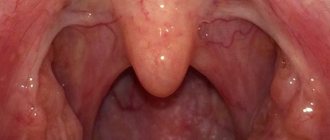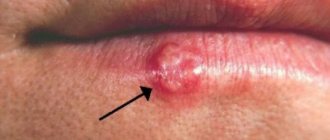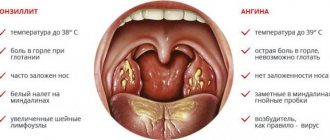Author:
- Elena Vitalievna Naumova, otolaryngologist, leading doctor of the clinic
3.00 (Votes: 10)
Acute tonsillitis with purulent exudate is considered the most common infection.
The disease occurs in both adults and children due to the entry of pathogenic microbes and bacteria into the oral cavity. It is not difficult to get a purulent sore throat even in the absence of direct contact with a sick person. Bacteria are spread through contact and airborne transmission, such as by sneezing or coughing in a public place or sharing household items.
Forms of purulent sore throat
There are two varieties:
- Purulent sore throat, affecting the lacunae of the tonsils. The infection is localized in the upper part of the throat and does not penetrate deeper. Purulent deposits are easily separated with a spatula.
- Purulent tonsillitis affecting the lymph nodes. The infection penetrates deeper and affects the lymphoid apparatus. Purulent exudate cannot be separated manually. The condition is extremely serious and threatens the formation of a peritonsillar abscess. Urgent medical attention and hospitalization are required.
Possible complications
Tonsillitis can cause local complications1,2:
- the formation of a paratonsillar abscess, characterized by severe intoxication, unilateral sore throat, bulging of one gland, deviation of the tongue towards the affected side, inability to fully open the mouth, forced tilt of the head towards the abscess;
- otitis media, or inflammation of the middle ear, accompanied by pain, congestion and a feeling of pressure in the ear, and in the absence of treatment - labyrinthitis (damage to the inner ear), manifested by tinnitus, nausea, vomiting, dizziness and a disturbance in the sense of balance.
Without treatment, catarrhal, follicular or other sore throat in adults and children can lead to the development of diseases such as1,2:
| Myocarditis | Inflammation of the muscular lining of the heart |
| Rheumatism | A systemic connective tissue disease associated with immune disorders that affects the heart and joints |
| Rheumatoid and infectious polyarthritis | Joint inflammation |
| Systemic lupus erythematosus | A connective tissue disease manifested by damage to small blood vessels of various organs |
| Glomerulonephritis and nephritis | Kidney inflammation |
| Sepsis | Blood poisoning |
Most often, such complications occur in people who have advanced the disease, consulted a doctor late, or did not receive treatment at all1.
Up to contents
Causes of sore throat (acute tonsillitis)
The accumulation of purulent “sacs” in the tonsils occurs for various reasons. The main causative agents of tonsillitis are streptococci, but viral and fungal pathogens, staphylococci and pneumococci are also found. If the body is healthy, then the infection will not develop, but the following factors can aggravate the condition:
- Injuries to the tonsils and nasopharynx.
- Weak immunity.
- Chronic diseases of the ear, nose and throat, for example, stomatitis, caries, rhinitis, etc. foci of infection increase the proliferation of pathogens.
- Local and general hypothermia, for example, eating ice cream or drinking cold water.
- Autumn-spring vitamin deficiency.
The pathogenic factor penetrates deep into the tissues of the tonsils, forming a focus of infection.
Prevention of sore throat
Effective preventive measures can reduce the number of exacerbations and prevent complications.
For prevention it is necessary:
- Strengthen immunity.
For example, harden yourself, go swimming and give your body moderate physical activity. Good results can be achieved with a sanatorium-resort holiday. - Eliminate sources of infection in the mouth in a timely manner.
Treat caries, pulpitis, and other dental diseases. - Quit alcohol and smoking.
- Avoid hypothermia and unnecessary contact with people,
especially during colds.
The main cause of pain and tissue swelling is the active proliferation of pathogenic microorganisms. Thanks to the activation of local immunity factors, pathogens are destroyed by the body’s own defenses5.
Clinical picture
Once a pathogen enters the body, two hours are enough for it to spread. Streptococci settle on the tonsils, weakening local immunity. The incubation period varies from several hours to 5 days.
The main differences between purulent tonsillitis are symptoms:
- A sharp pain in the throat occurs, which causes discomfort even at rest. The next day she becomes unbearable when talking or eating.
- Within a few hours, the body temperature rises to 39-40°C. Against the background of high temperature, it throws you either hot or cold, sweating increases and chills are present.
- Swallowing saliva causes severe, sharp pain.
- There is not enough air when breathing due to swelling of the tonsils.
- When examined with the naked eye, swollen tonsils and severe hyperemia of the back wall of the throat are visible. The next day the tongue and palate swell.
- There is a sensation of a foreign body in the nasopharynx, which intensifies when saliva is swabbed.
- Due to the fact that the tonsils are well supplied with blood, a yellowish-white dot appears on them, the boundaries of which quickly expand. The next day, the throat may become covered with many white purulent dots, which gradually merge into large ulcers.
Purulent tonsillitis in children occurs in a more severe form. Due to the excessive pressure of the swollen lymphoid tissue of the adenoids on the Eustachian tubes, the ears become blocked and there is tinnitus. If treatment is not attempted, the infection can spread to the ears, complicated by otitis media.
Usually the acute period lasts no more than one week if treatment is prescribed on time.
Important to know and remember! Purulent tonsillitis is a dangerous infectious disease, so the patient should be immediately isolated from household members.
Types and symptoms of sore throat
Effective treatment of sore throat is impossible1 without taking into account the nature of its causative agent and the form of the disease. The most common clinical types of inflammation of the tonsils1:
- catarrhal,
- follicular,
- lacunar.
Catarrhal
The disease begins acutely. Against the background of general malaise, weakness and weakness, burning sensations, soreness and dryness in the throat and pain when swallowing appear. Body temperature is within 37-37.9 0C. Upon examination, diffuse redness and slight swelling of the tonsils and arches of the soft palate are detected. The tongue is dry, covered with a white coating. Enlarged cervical and submandibular lymph nodes.
With the development of adenoiditis, a nasal voice is possible, which often happens in children; treatment of sore throat in such cases is often postponed due to the parents’ lack of knowledge2. In this case, the general symptoms of intoxication will be more pronounced than in adults, and the child may complain of pain in the ear when swallowing1,2.
Depending on the type of pathogen, the clinical picture of inflammation of the tonsils may vary. Thus, with adenoviral sore throat, in addition to redness of the tonsils, there are other signs of infection, in particular, redness spreads to the entire surface of the pharynx, nasopharynx and nose, and symptoms of conjunctivitis develop - redness, tearing and discharge from the eyes2. In the treatment of viral catarrhal tonsillitis, a special place is occupied by antiseptic preparations for gargling - antibiotics do not act on viruses3,4.
If the process is caused by Coxsackie viruses, tonsillitis is complemented by various manifestations of gastrointestinal disorder. Rashes appear on the surface of the tonsils and soft palate in the form of small blisters, reminiscent of herpes; treatment of such a sore throat requires a special approach due to the possibility of developing meningitis2.
Typically, catarrhal inflammation lasts 3-5 days, then it either disappears or passes into the next stage - follicular or lacunar tonsillitis2.
Follicular
If with catarrhal inflammation the process affects only the surface of the tonsils, then with follicular inflammation it spreads to the deep layers and the follicular apparatus. This is expressed in fever (up to 40 0C), chills, severe weakness, aches and pain in muscles and joints1. Sharp soreness in the throat makes it difficult to swallow and makes you refuse to eat.
In children, inflammation of the lymphoid tissue is accompanied by severe swelling, which can lead to difficulty breathing. Therefore, treating a sore throat at home is dangerous for the baby’s life.
With follicular inflammation, small follicles filled with pus are visible through the bright red surface of the mucous membrane of the tonsils1. The picture resembles a night sky strewn with stars1. Lymph nodes are enlarged and sharply painful.
Treatment of follicular tonsillitis necessarily involves the use of antibiotics1,2 - they are selected and prescribed by a doctor. In this case, after a few days the follicles are opened, freed from pus, and the small ulcers that form in their place quickly heal, leaving no trace behind1,2.
Lacunarnaya
More often the disease is more severe than follicular1. The temperature consistently stays above 39 0C, weakness and headache are literally bedridden, you constantly want to sleep, but body aches do not allow you to rest. Non-steroidal anti-inflammatory drugs used in the treatment of lacunar angina have an analgesic and antipyretic effect, which temporarily alleviates the condition4, 5.
The disease is accompanied by the appearance of a pus-like taste and bad breath. Pain when swallowing increases as suppuration and swelling increases.
A yellowish-white purulent coating appears on the reddened surface of the mucous membrane of the tonsils at the mouths of the lacunae, which is easily removed with a cotton swab1,2. Gradually there is so much of it that it covers most of the tonsils, but does not go beyond their boundaries.
On the 5–7th day, and when treating purulent sore throat with antibiotics on the 2–4th day, when the lacunae are cleared of pus, the condition improves1,2. The fever drops to 37.5-37.9 0C, the sore throat becomes less severe. After another 4-5 days, recovery occurs1,2.
Important! Manifestations of lacunar inflammatory process can be confused with symptoms of diphtheritic tonsillitis; Without treatment in children, diphtheria quickly leads to swelling of the tissues of the oropharynx, pharynx and larynx and, as a result, severe difficulty breathing. The gray-white filmy coating on the tonsils looks like pus, but it is tightly connected to the underlying tissues, spreading to the soft palate, the side walls of the pharynx and the larynx. If your child has tonsillitis, you should definitely see a doctor!
Up to contents
Treatment of purulent sore throat
Purulent tonsillitis threatens serious complications from the heart, kidneys, joints and soft tissues of the neck if therapy is chosen incorrectly or treatment is started late. It is for this reason that it is important to immediately consult a doctor when the first signs of a sore throat appear.
The basic treatment regimen for acute tonsillitis with purulent exudate:
- Taking antibiotics of the penicillin group or the macrolide group. You can't do without them. General and local remedies are prescribed. Antibiotics kill pathogenic microflora and after a few days the production of pus stops, blood circulation in the tonsils is restored.
- Taking anti-inflammatory lozenges, lozenges, lozenges.
- Gargling and irrigating the throat with different solutions every hour.
- Use of local antiseptics in the form of a spray.
- Taking antipyretic drugs.
- Vitamin therapy and taking immunomodulators.
The principle of treatment of acute tonsillitis in children is similar, the only differences are in the dosage of medications. The patient needs to observe strict bed rest, talk less and gargle more often.
If the prescribed drug therapy does not have positive dynamics within several days, the patient continues treatment in the hospital.
Due to the presence of purulent plaque on the palatine tonsils, eating is difficult or completely impossible, so you can eat only pureed and liquid food, and also drink a lot of warm water to relieve symptoms of intoxication.
Treatment
To avoid infecting others, you need to stay at home if treatment for sore throat will be carried out at home, or quickly go to the hospital if therapy involves a hospital stay.
The room should be ventilated as often as possible, and if possible, ultraviolet irradiation and wet cleaning should be carried out. Dishes and towels must be strictly individual.
Therapy for tonsillitis includes the creation of a gentle regime, general and local therapy.
Gentle mode
- At the beginning of the illness and the first couple of days after the temperature normalizes, it is better to stay in bed1. Then, when the fever goes away, you need to stay home and avoid physical activity.
- Increased temperature promotes increased sweating. Drinking plenty of drinks - will help reduce the symptoms of intoxication and avoid dehydration . Traditional treatment of sore throat with milk and honey is contraindicated. Sweet milk is an ideal breeding ground for bacteria; they multiply quickly, and this aggravates the course of the disease1.
- Food must be thermally processed, liquid or crushed, unsalted and unsweetened, without the addition of spices and spices1. It is better to choose easily digestible vegetable and dairy dishes with a low content of simple carbohydrates, boiled, stewed, steamed1.
Systemic drug therapy
Regardless of the severity of the condition, streptococcal tonsillitis is an indication for antibiotic therapy in the form of tablets or injections1,2,4. Therefore, if you have a sore throat, you should consult a doctor.
Antibiotics are especially important in the treatment of sore throat in children and people with weakened immune systems. They help prevent the development of complications2.
The choice of antibiotic and its dosage is determined by the doctor. In particular, beta-hemolytic streptococcus is sensitive to the latest generation of penicillin and macrolides1,2. The duration of treatment for sore throat with fever in both adults and children is on average 7 days2. Severe condition is an indication for hospitalization in an infectious diseases hospital, injection or drip administration of antibiotics2.
Antibiotics kill not only pathogenic bacteria, but also beneficial microflora of the oral cavity and digestive tract, which can trigger the development of candidiasis. To prevent it, antifungal drugs . They are also used to treat fungal tonsillitis, which usually occurs in patients with severely weakened immunity, for example, due to AIDS or taking medications that suppress the immune system2,5.
Non-steroidal anti-inflammatory drugs help to quickly stop the inflammatory process and fever, and reduce pain in the throat.
Desensitizing drugs are indicated to prevent allergies and autoimmune complications2.
Local therapy
Gargling with saline (sea salt, soda) solutions and antiseptic solutions helps to speed up the cleansing of the tonsils2,3. Traditional medicine suggests using infusions and decoctions of medicinal plants, for example, chamomile or calendula. Traditional medicine has more effective means - special preparations for gargling2,3, such as HEXORAL®. In the treatment of mild forms of viral tonsillitis, they are used as the main remedy to prevent the development of bacterial inflammation of the tonsils3, in other cases they become an addition to systemic antibacterial therapy.
The main active ingredient of the preparations HEXORAL® SOLUTION and HEXORAL® AEROSOL is the antiseptic hexetidine, which has antiseptic, antifungal, analgesic, hemostatic and deodorizing effects6.
HEXORAL® solution/aerosol:
- active against gram-positive bacteria, which include bethemolytic streptococcus, and fungi of the genus Candida, which are activated when immunity is reduced and antibiotics are used6;
- has a high safety profile, due to which it can be used not only in adults, but also in children from 3 years old6;
- relieves painful sensations when swallowing6;
- valid up to 12 hours6.
HEXORAL® TABS and TABS CLASSIC contain antiseptics with a wide spectrum of antimicrobial action. HEXORAL® TABS also contains a local anesthetic that helps relieve sore throat7. Various aromatic oils give the tablets a pleasant taste and aroma. “Mint” HEXORAL® TABS can be used in the treatment of children aged 4 years and older7. HEXORAL® TABS CLASSIC comes in orange, lemon, honey-lemon, and blackcurrant flavors and is approved for use from the age of six7.
HEXORAL® TABS EXTRA based on amylmetacresol, dichlorobenzyl alcohol and lidocaine has an antiseptic effect and, being active against most gram-positive and gram-negative bacteria and fungi, reduces tissue swelling and sore throat8. The drug is approved for use from 12 years of age8.
Indicators of recovery: normal body temperature for 5 days, disappearance of pain in the throat and when palpating the lymph nodes, normalization of blood counts and absence of complications1.
Up to contents
Prohibited methods of treatment for purulent sore throat
Unfortunately, patients often make independent treatment attempts, which only worsen the clinical picture. The following actions are prohibited:
- Pierce the ulcers with sharp objects.
- Push out, tear off or squeeze out ulcers.
- Treat tonsils with hydrogen peroxide, Lugol's solution, iodine.
- Warm your throat and gargle with hot water.
- Rinse with vinegar and concentrated alcohol solution.
- Apply compresses of vodka and alcohol to the throat.
Important to remember! It is very dangerous to try to remove purulent deposits on your own.
At the ENT CLINIC in Chertanovo, otolaryngologists immediately help patients. They carry out non-contact removal of purulent plaque using ultrasound on the CAVITAR device (USOL therapy). Pharyngoscopy and smear analysis are performed to determine sensitivity to antibiotics in order to prescribe an effective medicine. Specialists use modern drugs of the latest generation to improve the patient’s condition. Based on the severity of the disease, individual characteristics, and age of the patient, the clinic’s ENT doctor prescribes medications and gives recommendations for treating purulent tonsillitis at home.
Features of the spray angle
The quality of spraying the drug is no less important, as it allows you to evenly apply the product to the mucous membrane of the throat and tonsils. With this method, it becomes possible to cover all foci of inflammation, which, otherwise, can increase in area and cover healthy areas. The optimal requirements for spray quality are the following:
- drip type,
- uniformity of irrigation,
- wide spray angle.
Taken together, these characteristics make it possible to apply the drug evenly over the maximum area and avoid a situation where some areas of the mucous membrane are treated with the drug and others are not.
Tantum® Verde spray for the treatment of sore throat
Tantum® Verde is widely used in the treatment of various forms of sore throat, as it has the following advantages:
Wide spray angle. One click on the dispenser allows you to evenly cover the entire area of the oral mucosa1,2. This is especially convenient for children, in whom local treatment often becomes difficult.
Ease of use. Any procedure on a sore throat looks unpleasant. But Tantum®Verde spray, sprayed onto the mucous membrane, does not cause discomfort and does not require frequent use. To relieve symptoms and fight inflammation, it is enough to use the product 2-6 times a day according to the instructions3.
Relief of symptoms. Already a minute4 after spraying Tantum® Verde on the mucous membrane of the throat, a local anesthetic effect occurs, and within the first day from the start of treatment, inflammation is reduced and swelling is eliminated.
Complex action. Tantum® Verde has anti-inflammatory3, antibacterial3, analgesic4 effects, and, thanks to this, when using the spray, there is no need to use several separate drugs.
Types of sore throat
Sore throat differs in the degree of damage to the tonsils:
- catarrhal - the easiest option, in this case the inflammatory process affects only the mucous membrane, the tonsils are swollen and bright red
- lacunar – damage to the canals of the tonsils (lacuna), the tonsils are covered with a characteristic white coating;
- follicular - follicles are formed in the tonsils, which are filled with pus;
- combined - a severe form of tonsillitis, when both lacunae and follicles are affected on the tonsils.
Contraindications for sore throat
Sore throat is a disease that cannot be carried on your feet. Even in cases where it occurs in a mild form. This can trigger the infection to become chronic or severe, and also contributes to complications.
If you feel better, you should not stop taking antibiotics. It is also not recommended to smoke or drink alcohol, as smoke and alcohol can irritate a sore throat. It is necessary to exclude fatty, spicy, sour and solid foods from the diet for the same reason - so as not to irritate the throat.
It is extremely important to completely cure the disease so that it does not become chronic. Otherwise, you will face the fact that the infection will torment you regularly.










